Event Operations Management
VerifiedAdded on 2023/06/13
|11
|2778
|198
AI Summary
This report focuses on project management tools and their effectiveness in event operations management. It discusses the advantages, disadvantages, and limitations of each tool. The report also highlights the purpose of the report, project management, and the project management tools used.
Contribute Materials
Your contribution can guide someone’s learning journey. Share your
documents today.
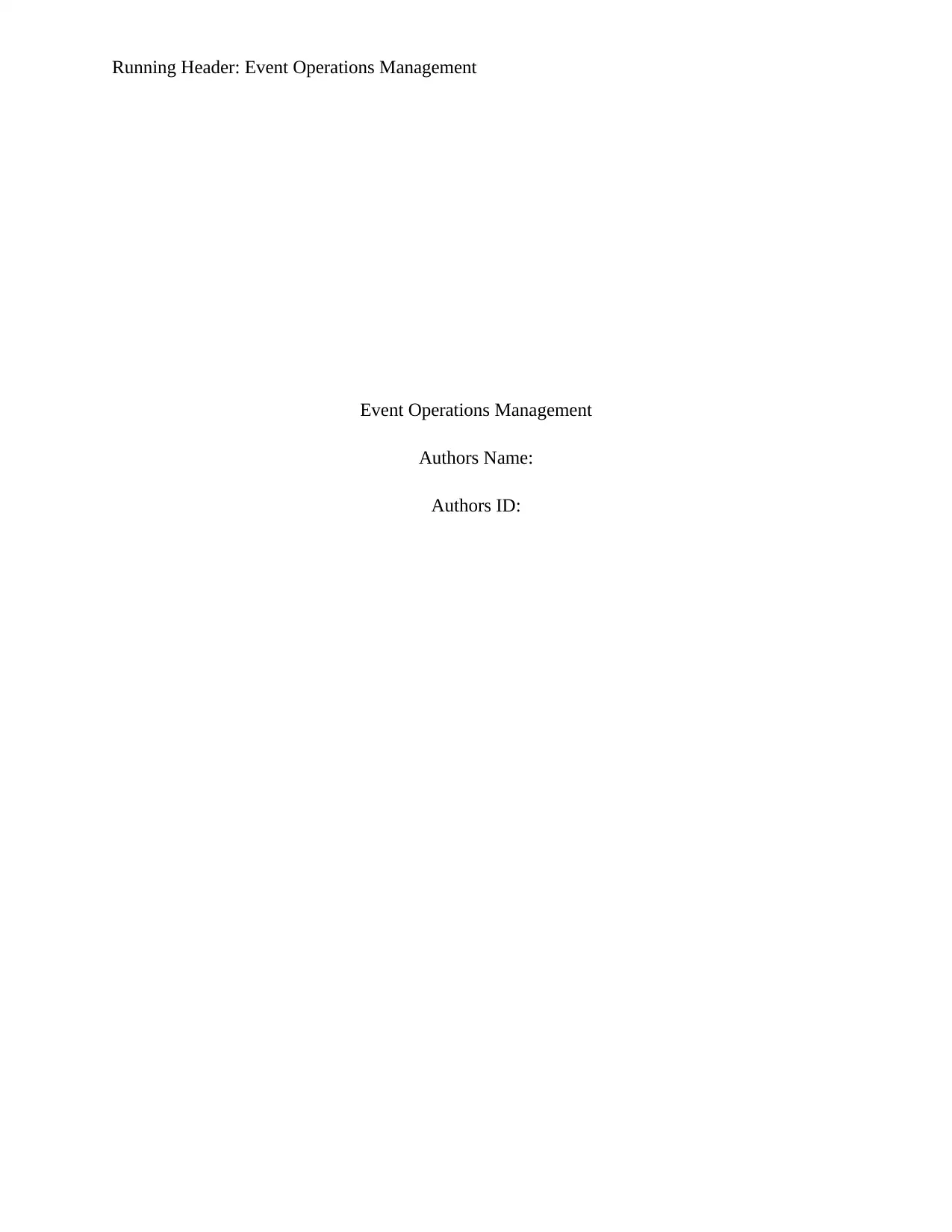
Running Header: Event Operations Management
Event Operations Management
Authors Name:
Authors ID:
Event Operations Management
Authors Name:
Authors ID:
Secure Best Marks with AI Grader
Need help grading? Try our AI Grader for instant feedback on your assignments.
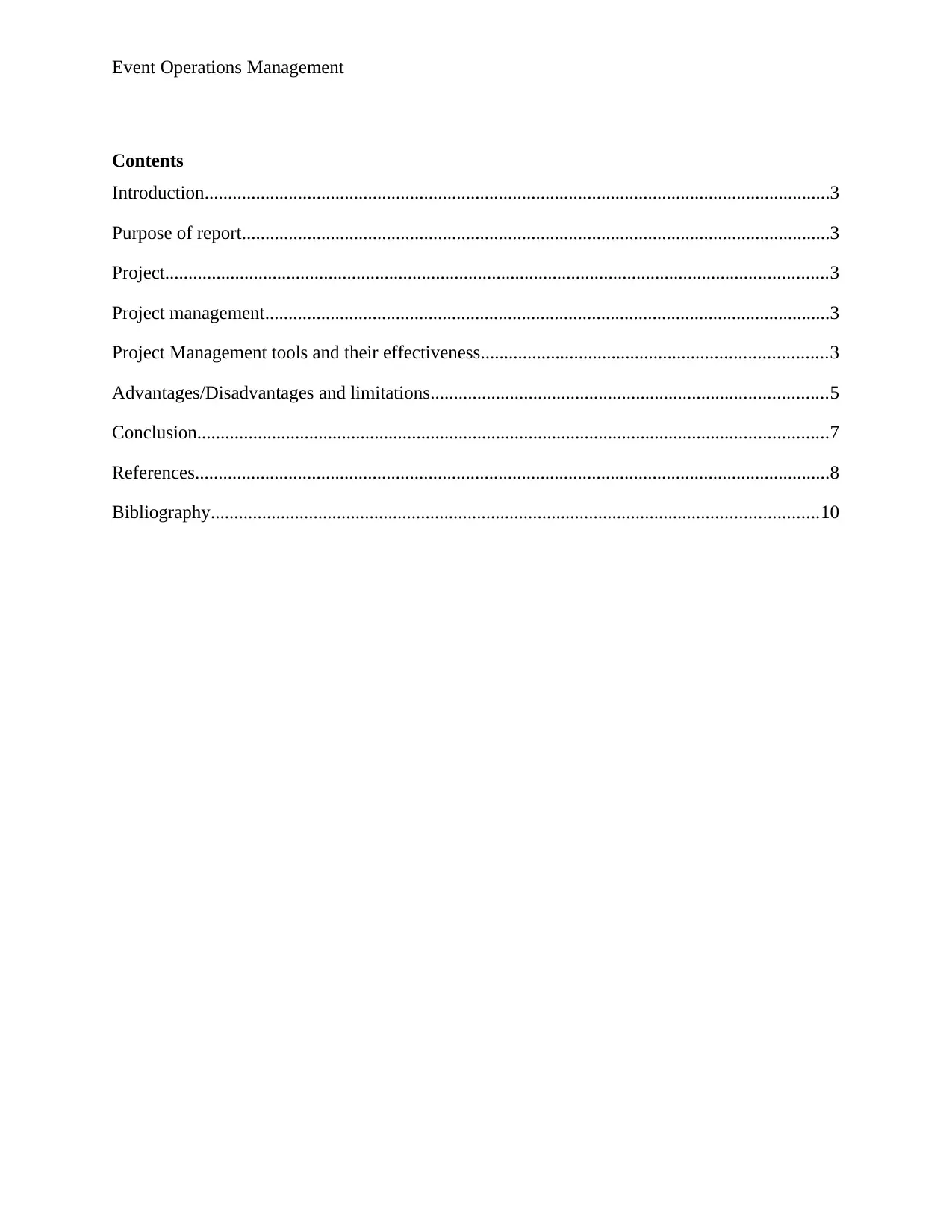
Event Operations Management
Contents
Introduction......................................................................................................................................3
Purpose of report..............................................................................................................................3
Project..............................................................................................................................................3
Project management.........................................................................................................................3
Project Management tools and their effectiveness..........................................................................3
Advantages/Disadvantages and limitations.....................................................................................5
Conclusion.......................................................................................................................................7
References........................................................................................................................................8
Bibliography..................................................................................................................................10
Contents
Introduction......................................................................................................................................3
Purpose of report..............................................................................................................................3
Project..............................................................................................................................................3
Project management.........................................................................................................................3
Project Management tools and their effectiveness..........................................................................3
Advantages/Disadvantages and limitations.....................................................................................5
Conclusion.......................................................................................................................................7
References........................................................................................................................................8
Bibliography..................................................................................................................................10
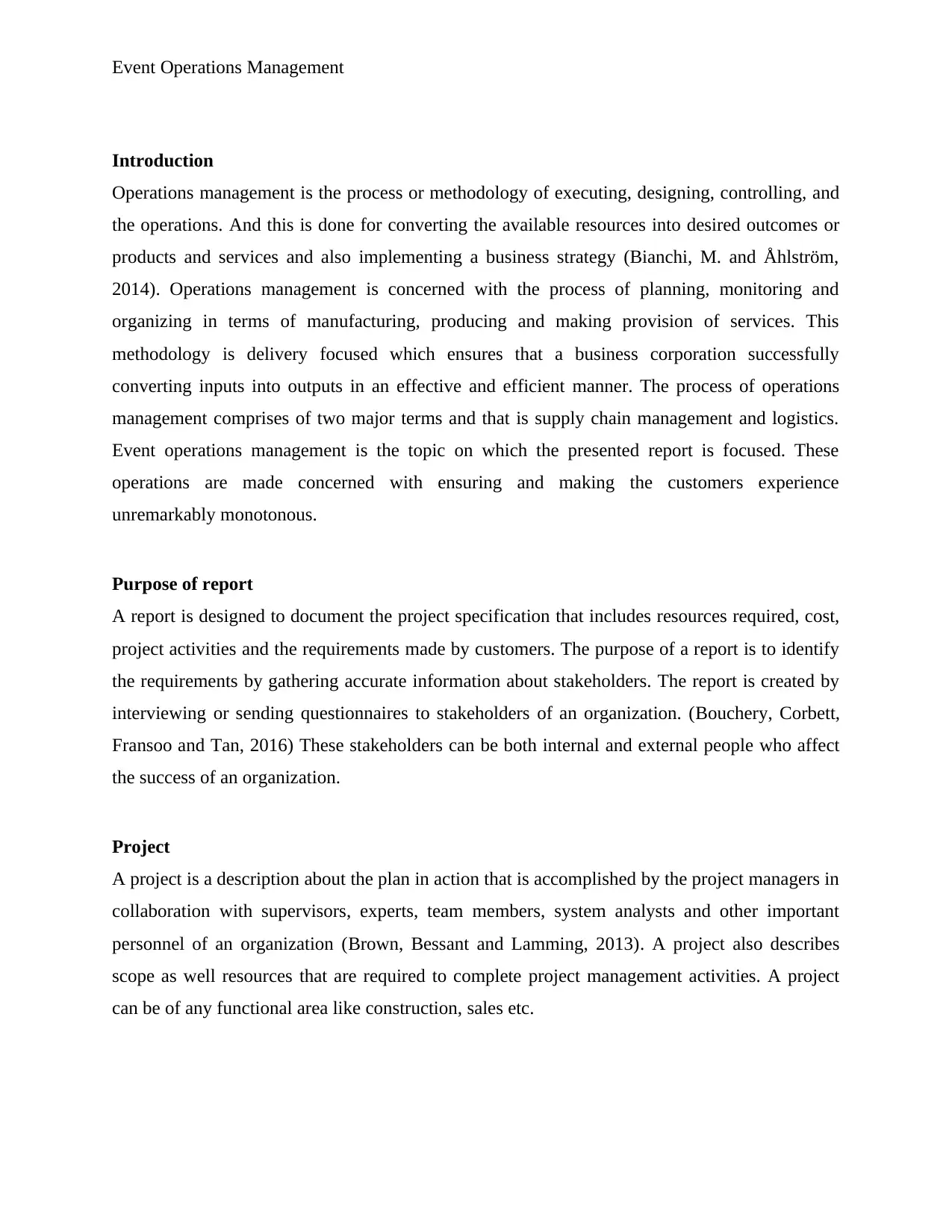
Event Operations Management
Introduction
Operations management is the process or methodology of executing, designing, controlling, and
the operations. And this is done for converting the available resources into desired outcomes or
products and services and also implementing a business strategy (Bianchi, M. and Åhlström,
2014). Operations management is concerned with the process of planning, monitoring and
organizing in terms of manufacturing, producing and making provision of services. This
methodology is delivery focused which ensures that a business corporation successfully
converting inputs into outputs in an effective and efficient manner. The process of operations
management comprises of two major terms and that is supply chain management and logistics.
Event operations management is the topic on which the presented report is focused. These
operations are made concerned with ensuring and making the customers experience
unremarkably monotonous.
Purpose of report
A report is designed to document the project specification that includes resources required, cost,
project activities and the requirements made by customers. The purpose of a report is to identify
the requirements by gathering accurate information about stakeholders. The report is created by
interviewing or sending questionnaires to stakeholders of an organization. (Bouchery, Corbett,
Fransoo and Tan, 2016) These stakeholders can be both internal and external people who affect
the success of an organization.
Project
A project is a description about the plan in action that is accomplished by the project managers in
collaboration with supervisors, experts, team members, system analysts and other important
personnel of an organization (Brown, Bessant and Lamming, 2013). A project also describes
scope as well resources that are required to complete project management activities. A project
can be of any functional area like construction, sales etc.
Introduction
Operations management is the process or methodology of executing, designing, controlling, and
the operations. And this is done for converting the available resources into desired outcomes or
products and services and also implementing a business strategy (Bianchi, M. and Åhlström,
2014). Operations management is concerned with the process of planning, monitoring and
organizing in terms of manufacturing, producing and making provision of services. This
methodology is delivery focused which ensures that a business corporation successfully
converting inputs into outputs in an effective and efficient manner. The process of operations
management comprises of two major terms and that is supply chain management and logistics.
Event operations management is the topic on which the presented report is focused. These
operations are made concerned with ensuring and making the customers experience
unremarkably monotonous.
Purpose of report
A report is designed to document the project specification that includes resources required, cost,
project activities and the requirements made by customers. The purpose of a report is to identify
the requirements by gathering accurate information about stakeholders. The report is created by
interviewing or sending questionnaires to stakeholders of an organization. (Bouchery, Corbett,
Fransoo and Tan, 2016) These stakeholders can be both internal and external people who affect
the success of an organization.
Project
A project is a description about the plan in action that is accomplished by the project managers in
collaboration with supervisors, experts, team members, system analysts and other important
personnel of an organization (Brown, Bessant and Lamming, 2013). A project also describes
scope as well resources that are required to complete project management activities. A project
can be of any functional area like construction, sales etc.
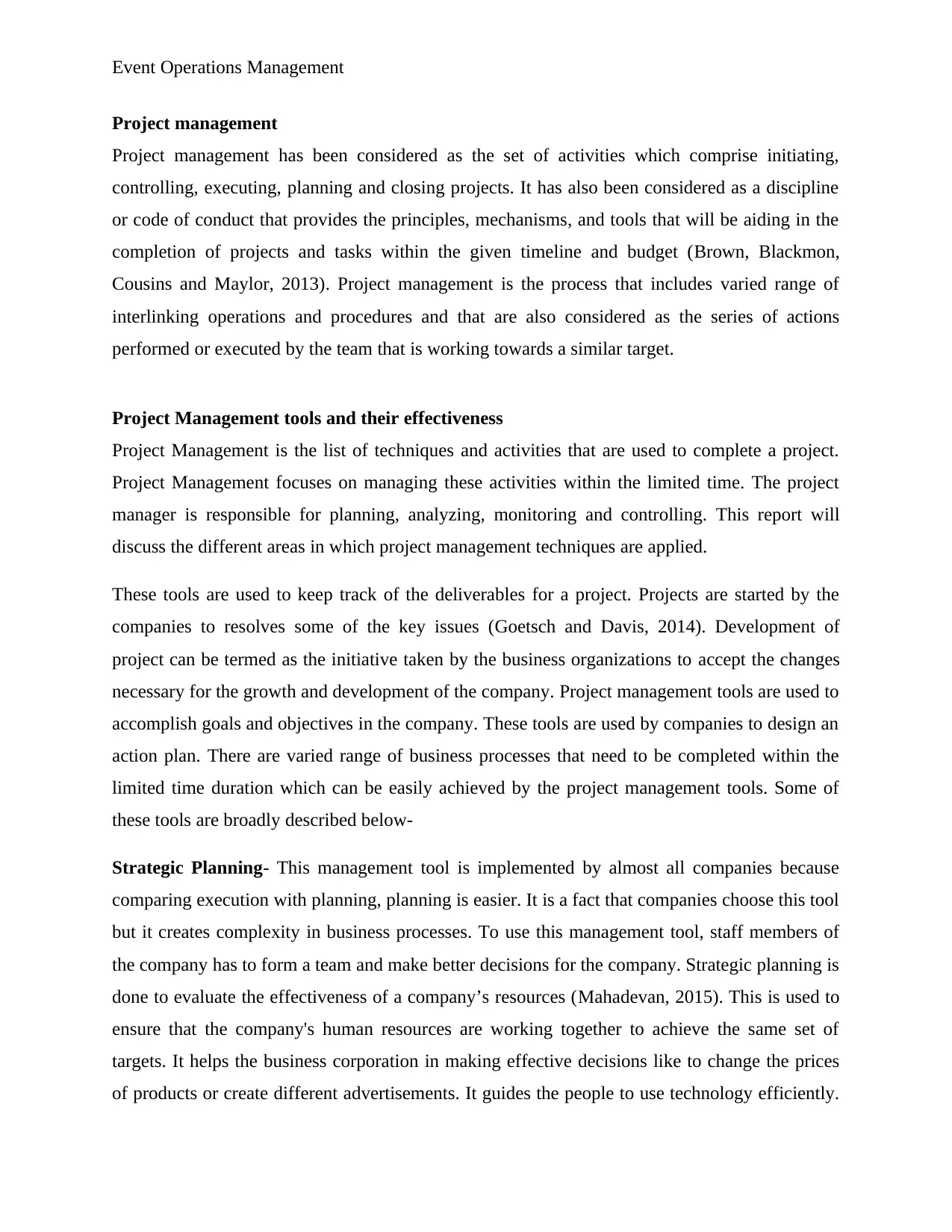
Event Operations Management
Project management
Project management has been considered as the set of activities which comprise initiating,
controlling, executing, planning and closing projects. It has also been considered as a discipline
or code of conduct that provides the principles, mechanisms, and tools that will be aiding in the
completion of projects and tasks within the given timeline and budget (Brown, Blackmon,
Cousins and Maylor, 2013). Project management is the process that includes varied range of
interlinking operations and procedures and that are also considered as the series of actions
performed or executed by the team that is working towards a similar target.
Project Management tools and their effectiveness
Project Management is the list of techniques and activities that are used to complete a project.
Project Management focuses on managing these activities within the limited time. The project
manager is responsible for planning, analyzing, monitoring and controlling. This report will
discuss the different areas in which project management techniques are applied.
These tools are used to keep track of the deliverables for a project. Projects are started by the
companies to resolves some of the key issues (Goetsch and Davis, 2014). Development of
project can be termed as the initiative taken by the business organizations to accept the changes
necessary for the growth and development of the company. Project management tools are used to
accomplish goals and objectives in the company. These tools are used by companies to design an
action plan. There are varied range of business processes that need to be completed within the
limited time duration which can be easily achieved by the project management tools. Some of
these tools are broadly described below-
Strategic Planning- This management tool is implemented by almost all companies because
comparing execution with planning, planning is easier. It is a fact that companies choose this tool
but it creates complexity in business processes. To use this management tool, staff members of
the company has to form a team and make better decisions for the company. Strategic planning is
done to evaluate the effectiveness of a company’s resources (Mahadevan, 2015). This is used to
ensure that the company's human resources are working together to achieve the same set of
targets. It helps the business corporation in making effective decisions like to change the prices
of products or create different advertisements. It guides the people to use technology efficiently.
Project management
Project management has been considered as the set of activities which comprise initiating,
controlling, executing, planning and closing projects. It has also been considered as a discipline
or code of conduct that provides the principles, mechanisms, and tools that will be aiding in the
completion of projects and tasks within the given timeline and budget (Brown, Blackmon,
Cousins and Maylor, 2013). Project management is the process that includes varied range of
interlinking operations and procedures and that are also considered as the series of actions
performed or executed by the team that is working towards a similar target.
Project Management tools and their effectiveness
Project Management is the list of techniques and activities that are used to complete a project.
Project Management focuses on managing these activities within the limited time. The project
manager is responsible for planning, analyzing, monitoring and controlling. This report will
discuss the different areas in which project management techniques are applied.
These tools are used to keep track of the deliverables for a project. Projects are started by the
companies to resolves some of the key issues (Goetsch and Davis, 2014). Development of
project can be termed as the initiative taken by the business organizations to accept the changes
necessary for the growth and development of the company. Project management tools are used to
accomplish goals and objectives in the company. These tools are used by companies to design an
action plan. There are varied range of business processes that need to be completed within the
limited time duration which can be easily achieved by the project management tools. Some of
these tools are broadly described below-
Strategic Planning- This management tool is implemented by almost all companies because
comparing execution with planning, planning is easier. It is a fact that companies choose this tool
but it creates complexity in business processes. To use this management tool, staff members of
the company has to form a team and make better decisions for the company. Strategic planning is
done to evaluate the effectiveness of a company’s resources (Mahadevan, 2015). This is used to
ensure that the company's human resources are working together to achieve the same set of
targets. It helps the business corporation in making effective decisions like to change the prices
of products or create different advertisements. It guides the people to use technology efficiently.
Secure Best Marks with AI Grader
Need help grading? Try our AI Grader for instant feedback on your assignments.
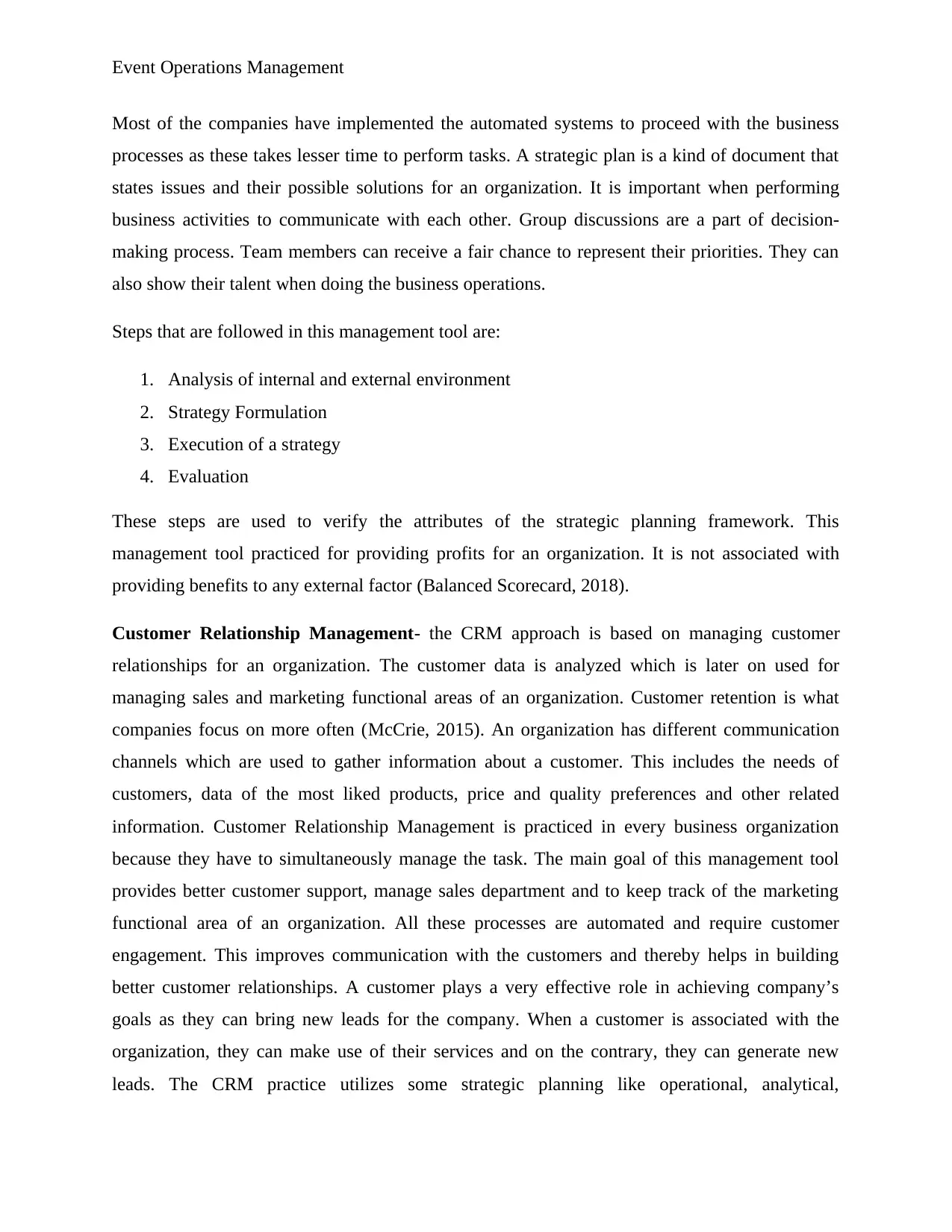
Event Operations Management
Most of the companies have implemented the automated systems to proceed with the business
processes as these takes lesser time to perform tasks. A strategic plan is a kind of document that
states issues and their possible solutions for an organization. It is important when performing
business activities to communicate with each other. Group discussions are a part of decision-
making process. Team members can receive a fair chance to represent their priorities. They can
also show their talent when doing the business operations.
Steps that are followed in this management tool are:
1. Analysis of internal and external environment
2. Strategy Formulation
3. Execution of a strategy
4. Evaluation
These steps are used to verify the attributes of the strategic planning framework. This
management tool practiced for providing profits for an organization. It is not associated with
providing benefits to any external factor (Balanced Scorecard, 2018).
Customer Relationship Management- the CRM approach is based on managing customer
relationships for an organization. The customer data is analyzed which is later on used for
managing sales and marketing functional areas of an organization. Customer retention is what
companies focus on more often (McCrie, 2015). An organization has different communication
channels which are used to gather information about a customer. This includes the needs of
customers, data of the most liked products, price and quality preferences and other related
information. Customer Relationship Management is practiced in every business organization
because they have to simultaneously manage the task. The main goal of this management tool
provides better customer support, manage sales department and to keep track of the marketing
functional area of an organization. All these processes are automated and require customer
engagement. This improves communication with the customers and thereby helps in building
better customer relationships. A customer plays a very effective role in achieving company’s
goals as they can bring new leads for the company. When a customer is associated with the
organization, they can make use of their services and on the contrary, they can generate new
leads. The CRM practice utilizes some strategic planning like operational, analytical,
Most of the companies have implemented the automated systems to proceed with the business
processes as these takes lesser time to perform tasks. A strategic plan is a kind of document that
states issues and their possible solutions for an organization. It is important when performing
business activities to communicate with each other. Group discussions are a part of decision-
making process. Team members can receive a fair chance to represent their priorities. They can
also show their talent when doing the business operations.
Steps that are followed in this management tool are:
1. Analysis of internal and external environment
2. Strategy Formulation
3. Execution of a strategy
4. Evaluation
These steps are used to verify the attributes of the strategic planning framework. This
management tool practiced for providing profits for an organization. It is not associated with
providing benefits to any external factor (Balanced Scorecard, 2018).
Customer Relationship Management- the CRM approach is based on managing customer
relationships for an organization. The customer data is analyzed which is later on used for
managing sales and marketing functional areas of an organization. Customer retention is what
companies focus on more often (McCrie, 2015). An organization has different communication
channels which are used to gather information about a customer. This includes the needs of
customers, data of the most liked products, price and quality preferences and other related
information. Customer Relationship Management is practiced in every business organization
because they have to simultaneously manage the task. The main goal of this management tool
provides better customer support, manage sales department and to keep track of the marketing
functional area of an organization. All these processes are automated and require customer
engagement. This improves communication with the customers and thereby helps in building
better customer relationships. A customer plays a very effective role in achieving company’s
goals as they can bring new leads for the company. When a customer is associated with the
organization, they can make use of their services and on the contrary, they can generate new
leads. The CRM practice utilizes some strategic planning like operational, analytical,
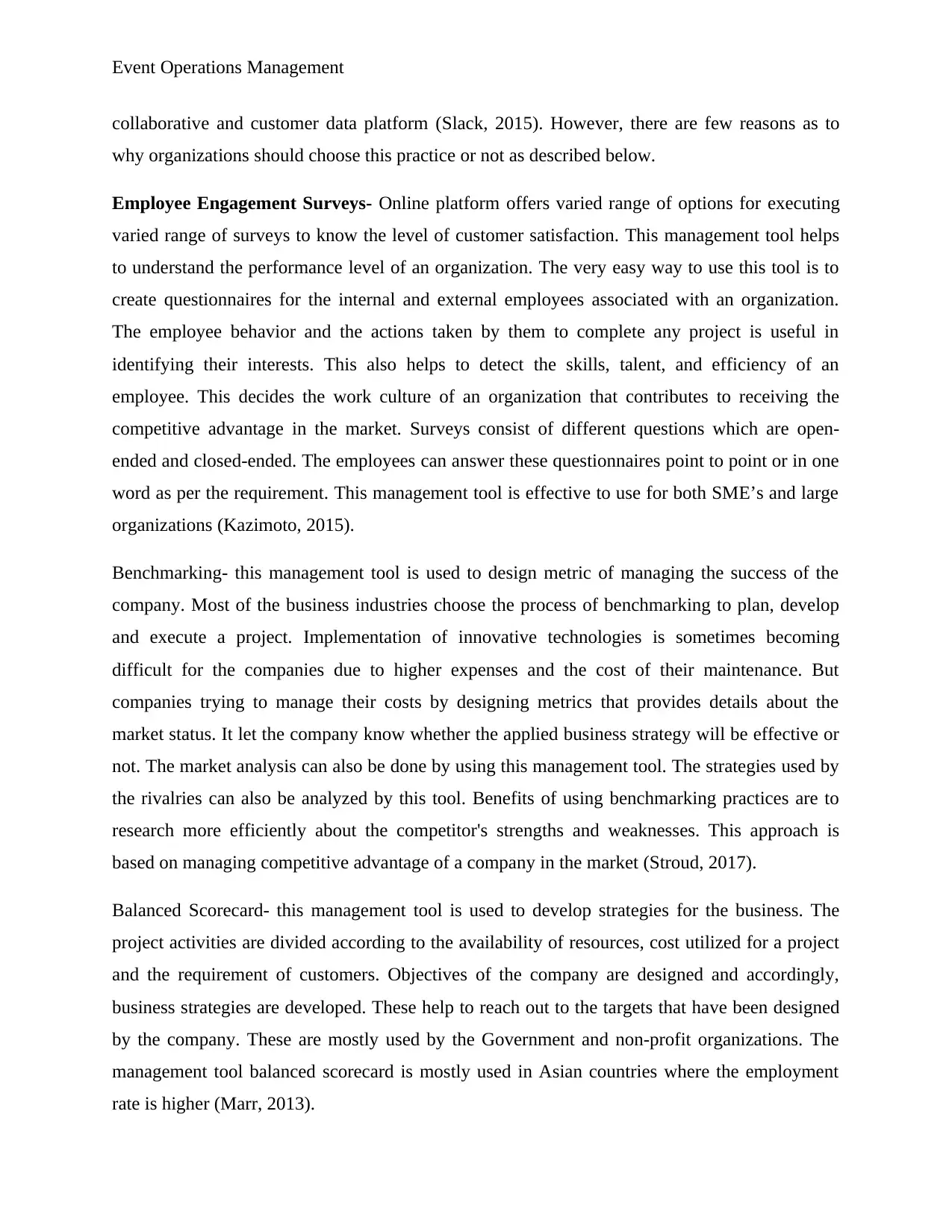
Event Operations Management
collaborative and customer data platform (Slack, 2015). However, there are few reasons as to
why organizations should choose this practice or not as described below.
Employee Engagement Surveys- Online platform offers varied range of options for executing
varied range of surveys to know the level of customer satisfaction. This management tool helps
to understand the performance level of an organization. The very easy way to use this tool is to
create questionnaires for the internal and external employees associated with an organization.
The employee behavior and the actions taken by them to complete any project is useful in
identifying their interests. This also helps to detect the skills, talent, and efficiency of an
employee. This decides the work culture of an organization that contributes to receiving the
competitive advantage in the market. Surveys consist of different questions which are open-
ended and closed-ended. The employees can answer these questionnaires point to point or in one
word as per the requirement. This management tool is effective to use for both SME’s and large
organizations (Kazimoto, 2015).
Benchmarking- this management tool is used to design metric of managing the success of the
company. Most of the business industries choose the process of benchmarking to plan, develop
and execute a project. Implementation of innovative technologies is sometimes becoming
difficult for the companies due to higher expenses and the cost of their maintenance. But
companies trying to manage their costs by designing metrics that provides details about the
market status. It let the company know whether the applied business strategy will be effective or
not. The market analysis can also be done by using this management tool. The strategies used by
the rivalries can also be analyzed by this tool. Benefits of using benchmarking practices are to
research more efficiently about the competitor's strengths and weaknesses. This approach is
based on managing competitive advantage of a company in the market (Stroud, 2017).
Balanced Scorecard- this management tool is used to develop strategies for the business. The
project activities are divided according to the availability of resources, cost utilized for a project
and the requirement of customers. Objectives of the company are designed and accordingly,
business strategies are developed. These help to reach out to the targets that have been designed
by the company. These are mostly used by the Government and non-profit organizations. The
management tool balanced scorecard is mostly used in Asian countries where the employment
rate is higher (Marr, 2013).
collaborative and customer data platform (Slack, 2015). However, there are few reasons as to
why organizations should choose this practice or not as described below.
Employee Engagement Surveys- Online platform offers varied range of options for executing
varied range of surveys to know the level of customer satisfaction. This management tool helps
to understand the performance level of an organization. The very easy way to use this tool is to
create questionnaires for the internal and external employees associated with an organization.
The employee behavior and the actions taken by them to complete any project is useful in
identifying their interests. This also helps to detect the skills, talent, and efficiency of an
employee. This decides the work culture of an organization that contributes to receiving the
competitive advantage in the market. Surveys consist of different questions which are open-
ended and closed-ended. The employees can answer these questionnaires point to point or in one
word as per the requirement. This management tool is effective to use for both SME’s and large
organizations (Kazimoto, 2015).
Benchmarking- this management tool is used to design metric of managing the success of the
company. Most of the business industries choose the process of benchmarking to plan, develop
and execute a project. Implementation of innovative technologies is sometimes becoming
difficult for the companies due to higher expenses and the cost of their maintenance. But
companies trying to manage their costs by designing metrics that provides details about the
market status. It let the company know whether the applied business strategy will be effective or
not. The market analysis can also be done by using this management tool. The strategies used by
the rivalries can also be analyzed by this tool. Benefits of using benchmarking practices are to
research more efficiently about the competitor's strengths and weaknesses. This approach is
based on managing competitive advantage of a company in the market (Stroud, 2017).
Balanced Scorecard- this management tool is used to develop strategies for the business. The
project activities are divided according to the availability of resources, cost utilized for a project
and the requirement of customers. Objectives of the company are designed and accordingly,
business strategies are developed. These help to reach out to the targets that have been designed
by the company. These are mostly used by the Government and non-profit organizations. The
management tool balanced scorecard is mostly used in Asian countries where the employment
rate is higher (Marr, 2013).
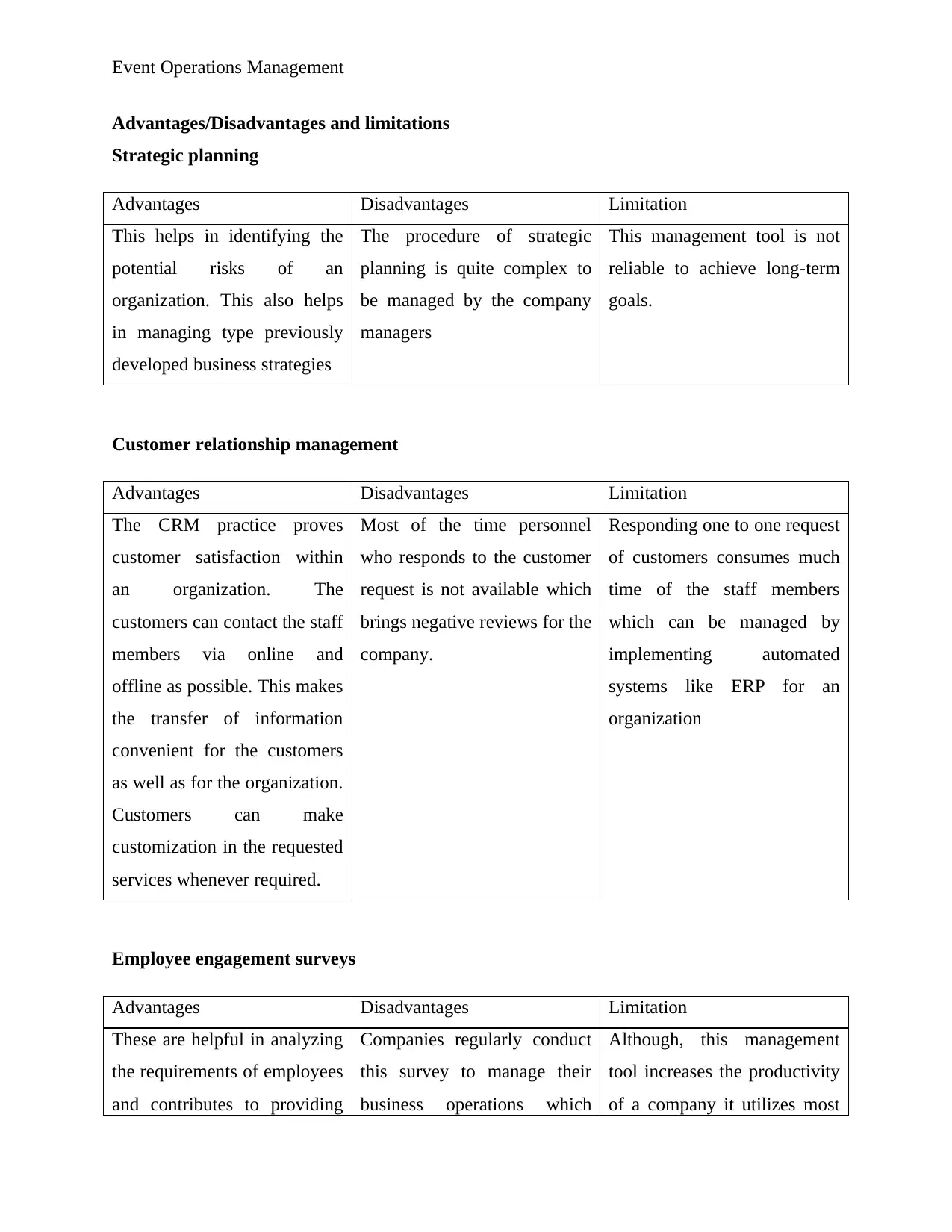
Event Operations Management
Advantages/Disadvantages and limitations
Strategic planning
Advantages Disadvantages Limitation
This helps in identifying the
potential risks of an
organization. This also helps
in managing type previously
developed business strategies
The procedure of strategic
planning is quite complex to
be managed by the company
managers
This management tool is not
reliable to achieve long-term
goals.
Customer relationship management
Advantages Disadvantages Limitation
The CRM practice proves
customer satisfaction within
an organization. The
customers can contact the staff
members via online and
offline as possible. This makes
the transfer of information
convenient for the customers
as well as for the organization.
Customers can make
customization in the requested
services whenever required.
Most of the time personnel
who responds to the customer
request is not available which
brings negative reviews for the
company.
Responding one to one request
of customers consumes much
time of the staff members
which can be managed by
implementing automated
systems like ERP for an
organization
Employee engagement surveys
Advantages Disadvantages Limitation
These are helpful in analyzing
the requirements of employees
and contributes to providing
Companies regularly conduct
this survey to manage their
business operations which
Although, this management
tool increases the productivity
of a company it utilizes most
Advantages/Disadvantages and limitations
Strategic planning
Advantages Disadvantages Limitation
This helps in identifying the
potential risks of an
organization. This also helps
in managing type previously
developed business strategies
The procedure of strategic
planning is quite complex to
be managed by the company
managers
This management tool is not
reliable to achieve long-term
goals.
Customer relationship management
Advantages Disadvantages Limitation
The CRM practice proves
customer satisfaction within
an organization. The
customers can contact the staff
members via online and
offline as possible. This makes
the transfer of information
convenient for the customers
as well as for the organization.
Customers can make
customization in the requested
services whenever required.
Most of the time personnel
who responds to the customer
request is not available which
brings negative reviews for the
company.
Responding one to one request
of customers consumes much
time of the staff members
which can be managed by
implementing automated
systems like ERP for an
organization
Employee engagement surveys
Advantages Disadvantages Limitation
These are helpful in analyzing
the requirements of employees
and contributes to providing
Companies regularly conduct
this survey to manage their
business operations which
Although, this management
tool increases the productivity
of a company it utilizes most
Paraphrase This Document
Need a fresh take? Get an instant paraphrase of this document with our AI Paraphraser
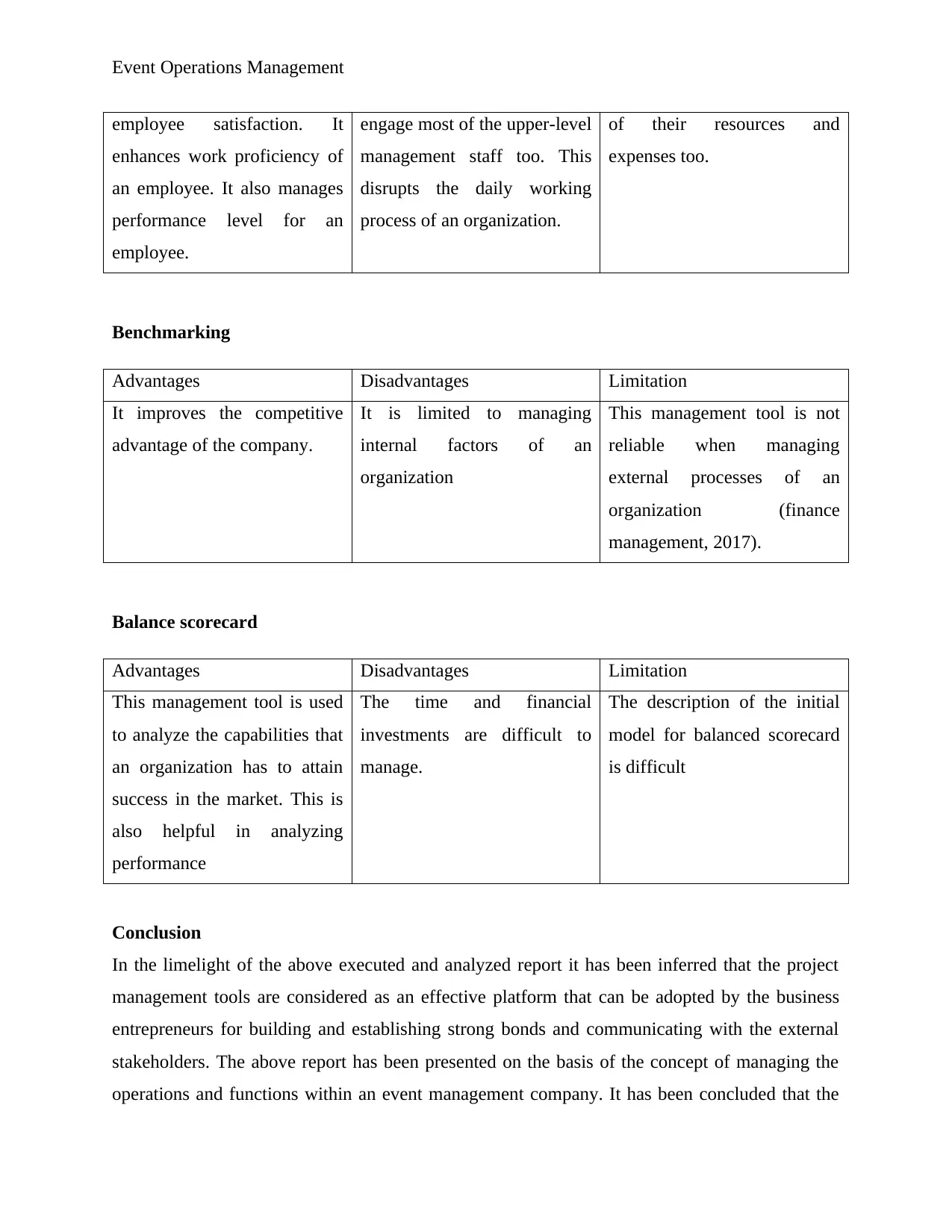
Event Operations Management
employee satisfaction. It
enhances work proficiency of
an employee. It also manages
performance level for an
employee.
engage most of the upper-level
management staff too. This
disrupts the daily working
process of an organization.
of their resources and
expenses too.
Benchmarking
Advantages Disadvantages Limitation
It improves the competitive
advantage of the company.
It is limited to managing
internal factors of an
organization
This management tool is not
reliable when managing
external processes of an
organization (finance
management, 2017).
Balance scorecard
Advantages Disadvantages Limitation
This management tool is used
to analyze the capabilities that
an organization has to attain
success in the market. This is
also helpful in analyzing
performance
The time and financial
investments are difficult to
manage.
The description of the initial
model for balanced scorecard
is difficult
Conclusion
In the limelight of the above executed and analyzed report it has been inferred that the project
management tools are considered as an effective platform that can be adopted by the business
entrepreneurs for building and establishing strong bonds and communicating with the external
stakeholders. The above report has been presented on the basis of the concept of managing the
operations and functions within an event management company. It has been concluded that the
employee satisfaction. It
enhances work proficiency of
an employee. It also manages
performance level for an
employee.
engage most of the upper-level
management staff too. This
disrupts the daily working
process of an organization.
of their resources and
expenses too.
Benchmarking
Advantages Disadvantages Limitation
It improves the competitive
advantage of the company.
It is limited to managing
internal factors of an
organization
This management tool is not
reliable when managing
external processes of an
organization (finance
management, 2017).
Balance scorecard
Advantages Disadvantages Limitation
This management tool is used
to analyze the capabilities that
an organization has to attain
success in the market. This is
also helpful in analyzing
performance
The time and financial
investments are difficult to
manage.
The description of the initial
model for balanced scorecard
is difficult
Conclusion
In the limelight of the above executed and analyzed report it has been inferred that the project
management tools are considered as an effective platform that can be adopted by the business
entrepreneurs for building and establishing strong bonds and communicating with the external
stakeholders. The above report has been presented on the basis of the concept of managing the
operations and functions within an event management company. It has been concluded that the
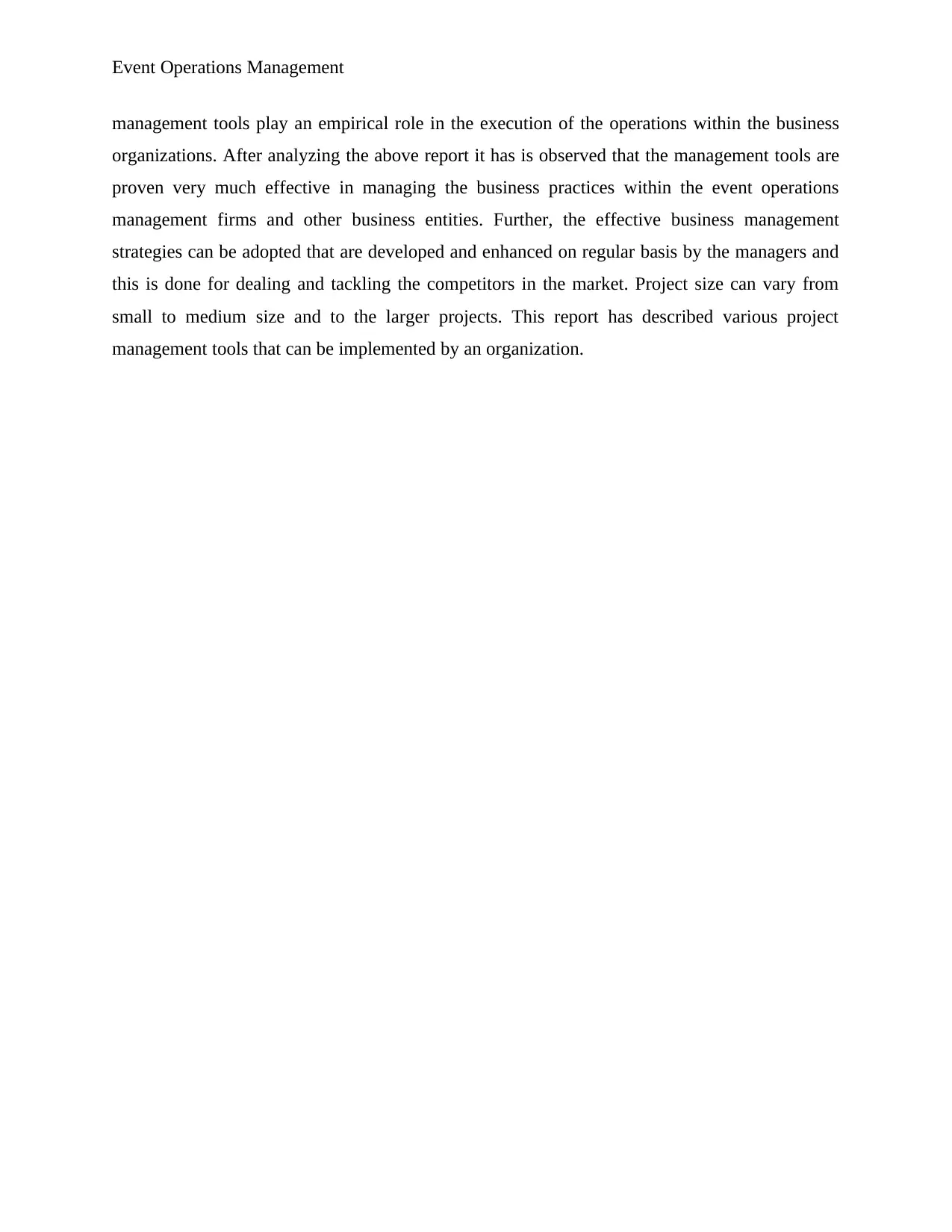
Event Operations Management
management tools play an empirical role in the execution of the operations within the business
organizations. After analyzing the above report it has is observed that the management tools are
proven very much effective in managing the business practices within the event operations
management firms and other business entities. Further, the effective business management
strategies can be adopted that are developed and enhanced on regular basis by the managers and
this is done for dealing and tackling the competitors in the market. Project size can vary from
small to medium size and to the larger projects. This report has described various project
management tools that can be implemented by an organization.
management tools play an empirical role in the execution of the operations within the business
organizations. After analyzing the above report it has is observed that the management tools are
proven very much effective in managing the business practices within the event operations
management firms and other business entities. Further, the effective business management
strategies can be adopted that are developed and enhanced on regular basis by the managers and
this is done for dealing and tackling the competitors in the market. Project size can vary from
small to medium size and to the larger projects. This report has described various project
management tools that can be implemented by an organization.
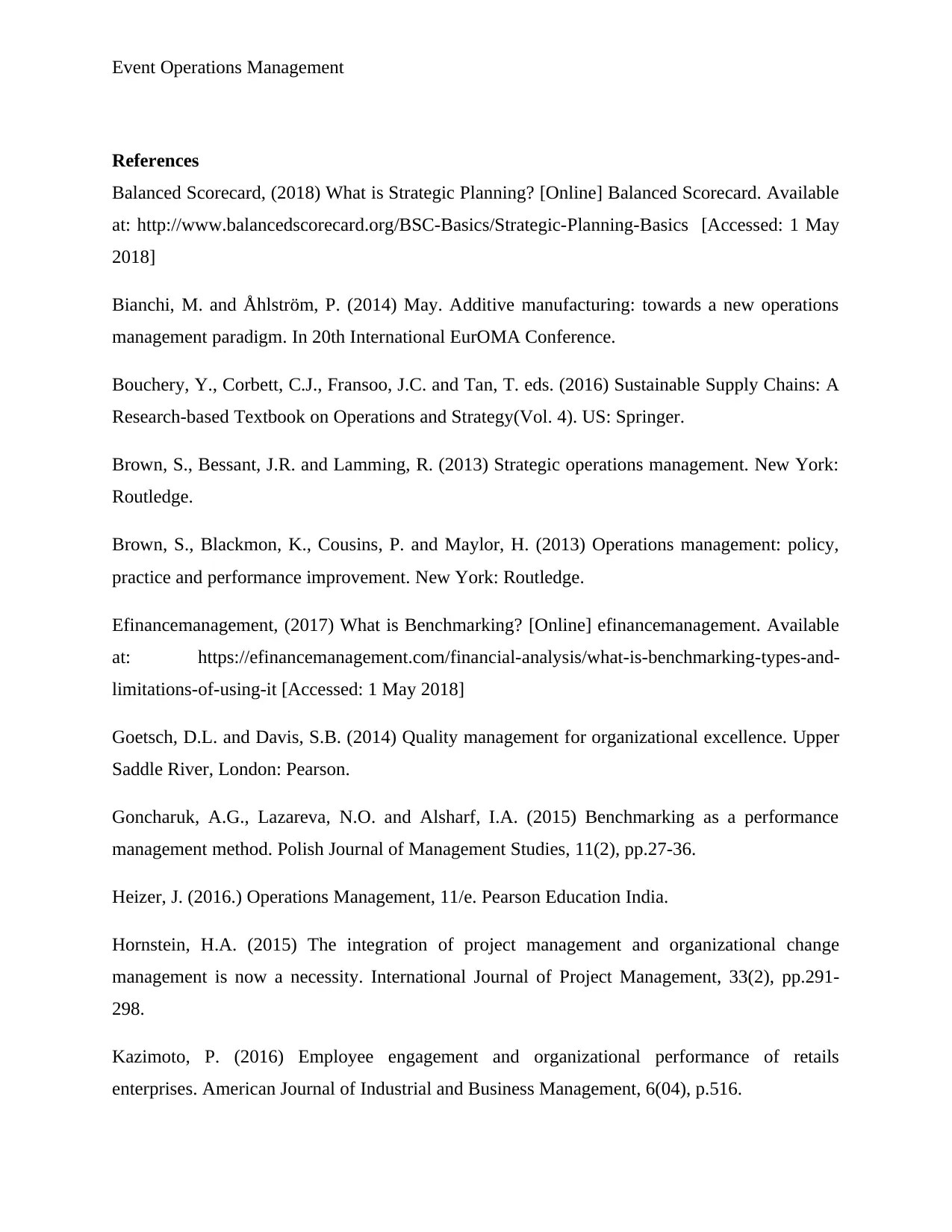
Event Operations Management
References
Balanced Scorecard, (2018) What is Strategic Planning? [Online] Balanced Scorecard. Available
at: http://www.balancedscorecard.org/BSC-Basics/Strategic-Planning-Basics [Accessed: 1 May
2018]
Bianchi, M. and Åhlström, P. (2014) May. Additive manufacturing: towards a new operations
management paradigm. In 20th International EurOMA Conference.
Bouchery, Y., Corbett, C.J., Fransoo, J.C. and Tan, T. eds. (2016) Sustainable Supply Chains: A
Research-based Textbook on Operations and Strategy(Vol. 4). US: Springer.
Brown, S., Bessant, J.R. and Lamming, R. (2013) Strategic operations management. New York:
Routledge.
Brown, S., Blackmon, K., Cousins, P. and Maylor, H. (2013) Operations management: policy,
practice and performance improvement. New York: Routledge.
Efinancemanagement, (2017) What is Benchmarking? [Online] efinancemanagement. Available
at: https://efinancemanagement.com/financial-analysis/what-is-benchmarking-types-and-
limitations-of-using-it [Accessed: 1 May 2018]
Goetsch, D.L. and Davis, S.B. (2014) Quality management for organizational excellence. Upper
Saddle River, London: Pearson.
Goncharuk, A.G., Lazareva, N.O. and Alsharf, I.A. (2015) Benchmarking as a performance
management method. Polish Journal of Management Studies, 11(2), pp.27-36.
Heizer, J. (2016.) Operations Management, 11/e. Pearson Education India.
Hornstein, H.A. (2015) The integration of project management and organizational change
management is now a necessity. International Journal of Project Management, 33(2), pp.291-
298.
Kazimoto, P. (2016) Employee engagement and organizational performance of retails
enterprises. American Journal of Industrial and Business Management, 6(04), p.516.
References
Balanced Scorecard, (2018) What is Strategic Planning? [Online] Balanced Scorecard. Available
at: http://www.balancedscorecard.org/BSC-Basics/Strategic-Planning-Basics [Accessed: 1 May
2018]
Bianchi, M. and Åhlström, P. (2014) May. Additive manufacturing: towards a new operations
management paradigm. In 20th International EurOMA Conference.
Bouchery, Y., Corbett, C.J., Fransoo, J.C. and Tan, T. eds. (2016) Sustainable Supply Chains: A
Research-based Textbook on Operations and Strategy(Vol. 4). US: Springer.
Brown, S., Bessant, J.R. and Lamming, R. (2013) Strategic operations management. New York:
Routledge.
Brown, S., Blackmon, K., Cousins, P. and Maylor, H. (2013) Operations management: policy,
practice and performance improvement. New York: Routledge.
Efinancemanagement, (2017) What is Benchmarking? [Online] efinancemanagement. Available
at: https://efinancemanagement.com/financial-analysis/what-is-benchmarking-types-and-
limitations-of-using-it [Accessed: 1 May 2018]
Goetsch, D.L. and Davis, S.B. (2014) Quality management for organizational excellence. Upper
Saddle River, London: Pearson.
Goncharuk, A.G., Lazareva, N.O. and Alsharf, I.A. (2015) Benchmarking as a performance
management method. Polish Journal of Management Studies, 11(2), pp.27-36.
Heizer, J. (2016.) Operations Management, 11/e. Pearson Education India.
Hornstein, H.A. (2015) The integration of project management and organizational change
management is now a necessity. International Journal of Project Management, 33(2), pp.291-
298.
Kazimoto, P. (2016) Employee engagement and organizational performance of retails
enterprises. American Journal of Industrial and Business Management, 6(04), p.516.
Secure Best Marks with AI Grader
Need help grading? Try our AI Grader for instant feedback on your assignments.
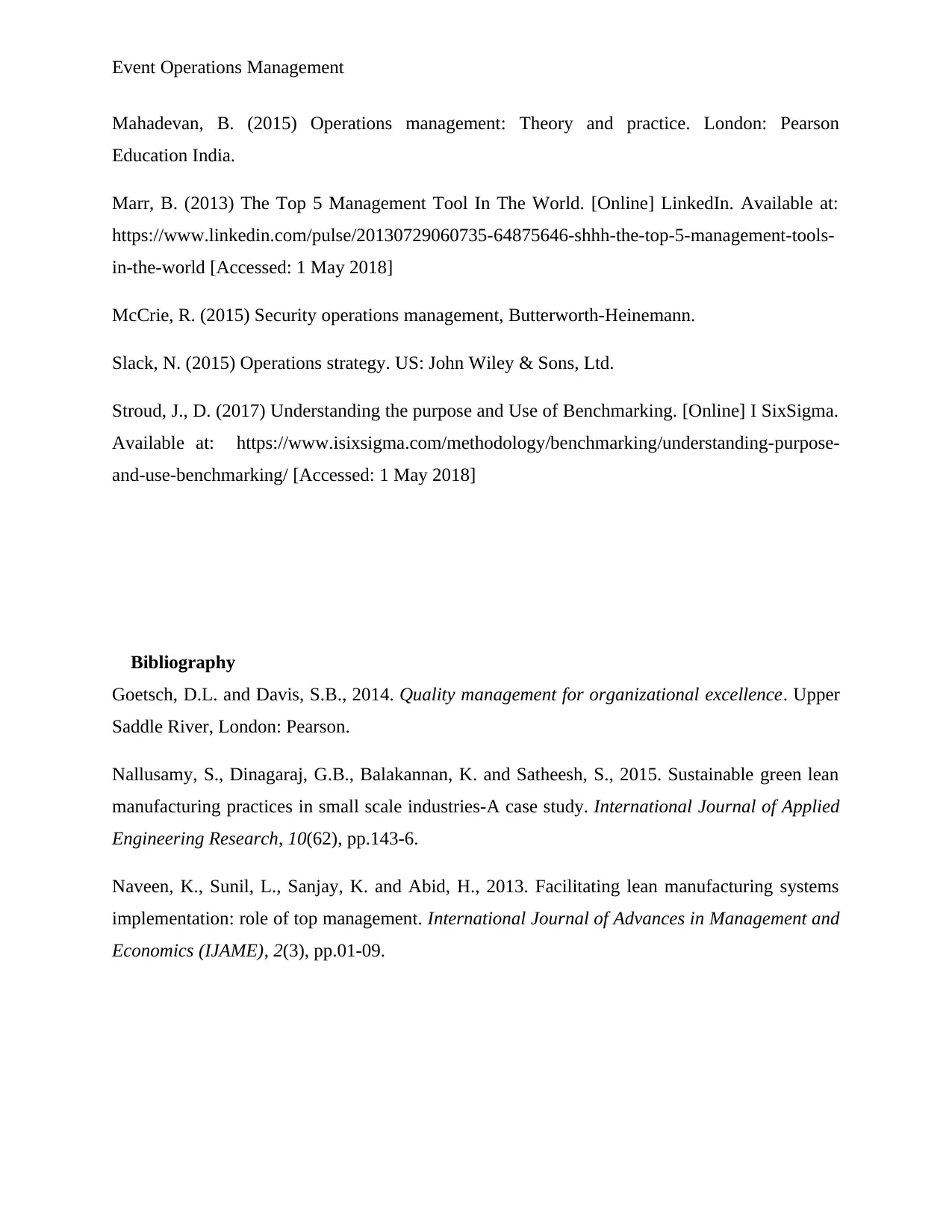
Event Operations Management
Mahadevan, B. (2015) Operations management: Theory and practice. London: Pearson
Education India.
Marr, B. (2013) The Top 5 Management Tool In The World. [Online] LinkedIn. Available at:
https://www.linkedin.com/pulse/20130729060735-64875646-shhh-the-top-5-management-tools-
in-the-world [Accessed: 1 May 2018]
McCrie, R. (2015) Security operations management, Butterworth-Heinemann.
Slack, N. (2015) Operations strategy. US: John Wiley & Sons, Ltd.
Stroud, J., D. (2017) Understanding the purpose and Use of Benchmarking. [Online] I SixSigma.
Available at: https://www.isixsigma.com/methodology/benchmarking/understanding-purpose-
and-use-benchmarking/ [Accessed: 1 May 2018]
Bibliography
Goetsch, D.L. and Davis, S.B., 2014. Quality management for organizational excellence. Upper
Saddle River, London: Pearson.
Nallusamy, S., Dinagaraj, G.B., Balakannan, K. and Satheesh, S., 2015. Sustainable green lean
manufacturing practices in small scale industries-A case study. International Journal of Applied
Engineering Research, 10(62), pp.143-6.
Naveen, K., Sunil, L., Sanjay, K. and Abid, H., 2013. Facilitating lean manufacturing systems
implementation: role of top management. International Journal of Advances in Management and
Economics (IJAME), 2(3), pp.01-09.
Mahadevan, B. (2015) Operations management: Theory and practice. London: Pearson
Education India.
Marr, B. (2013) The Top 5 Management Tool In The World. [Online] LinkedIn. Available at:
https://www.linkedin.com/pulse/20130729060735-64875646-shhh-the-top-5-management-tools-
in-the-world [Accessed: 1 May 2018]
McCrie, R. (2015) Security operations management, Butterworth-Heinemann.
Slack, N. (2015) Operations strategy. US: John Wiley & Sons, Ltd.
Stroud, J., D. (2017) Understanding the purpose and Use of Benchmarking. [Online] I SixSigma.
Available at: https://www.isixsigma.com/methodology/benchmarking/understanding-purpose-
and-use-benchmarking/ [Accessed: 1 May 2018]
Bibliography
Goetsch, D.L. and Davis, S.B., 2014. Quality management for organizational excellence. Upper
Saddle River, London: Pearson.
Nallusamy, S., Dinagaraj, G.B., Balakannan, K. and Satheesh, S., 2015. Sustainable green lean
manufacturing practices in small scale industries-A case study. International Journal of Applied
Engineering Research, 10(62), pp.143-6.
Naveen, K., Sunil, L., Sanjay, K. and Abid, H., 2013. Facilitating lean manufacturing systems
implementation: role of top management. International Journal of Advances in Management and
Economics (IJAME), 2(3), pp.01-09.
1 out of 11
Related Documents
Your All-in-One AI-Powered Toolkit for Academic Success.
+13062052269
info@desklib.com
Available 24*7 on WhatsApp / Email
![[object Object]](/_next/static/media/star-bottom.7253800d.svg)
Unlock your academic potential
© 2024 | Zucol Services PVT LTD | All rights reserved.




